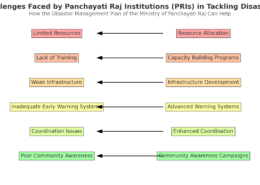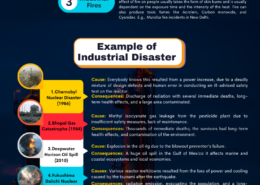In India, flash floods cause terrible damage to the homes located in low-lying areas. Talk about the causes of the regular flash floods that occur in India. Emphasize their influence as well. (Answer in 250 words)
A chemical disaster is the accidental and uncontrolled release of a toxic substance, potentially resulting in harm to public health and the environment. Some examples of chemical disasters from the Indian context include: India has witnessed the world's worst chemical (industrial) disaster ie. the 'Read more
A chemical disaster is the accidental and uncontrolled release of a toxic substance, potentially resulting in harm to public health and the environment.
Some examples of chemical disasters from the Indian context include:
- India has witnessed the world’s worst chemical (industrial) disaster ie. the ‘Bhopal Gas Tragedy’ in the year 1984, where thousands of people died or were injured due to the accidental release of toxic gas Methyl Isocyanate (MIC).
- In 2008, people at Tata Motors got exposed to dense pale green pungent, and poisonous gas, chlorine.
- In 2020, a gas leak from a styrene plant owned by South Korean electronics giant LG affected five villages in Visakhapatnam in Andhra Pradesh.
- According to the National Disaster Management Authority (NDMA), in the last two decades, 130 significant chemical accidents were reported in India, which resulted in 259 deaths and 563 injuries.
Challenges to mitigate chemical disasters:
- Lack of awareness: Inappropriate and haphazard construction and lack of awareness and preparedness on the part of the community enhance the vulnerability to such disasters.
- Lack of coordination: Various stakeholders like the fire department, health department, civil society, etc. involved in chemical disaster management lack adequate ability to act in collaboration when a disaster occurs.
- Lack of proper implementation of existing laws: India does not stringently enforce provisions laid out in the Environment (Protection) Act, 1986 and Disaster Management Act, 2005 for effective on-site as well as off-site emergency management planning.
- Negligence in handling hazardous chemicals: Handling large quantities of hazardous chemicals in installations, isolated storages, and during transportation, poses the grave risk of a sudden release of copious quantities of toxicants in the environment.
- Unorganized sector: Thousands of factories in the unorganized sector deal with numerous hazardous materials, which is exacerbated by a lack of protective equipment.
Laws such as the Explosives Act, of 1884, the Petroleum Act, of 1934, the Factories Act, of 1948, the Insecticides Act, of 1968, the Environment (Protection) Act, of 1986, the Public Liability Insurance Act, of 1991, and the Disaster Management Act, of 2005, etc. have been implemented in India to deal with chemical disasters. Although a comprehensive legal framework exists in our country to address chemical risk, additional measures are required to address the above-mentioned challenges. These include:
- Hazard mapping: Accurate information about the location, type, and quantities of hazardous material being stored, used, or produced should be known at district and state levels.
- Proper inspection: A regular and systematic inspection of chemical plants and storage facilities of hazardous materials can prevent such disasters if laid down norms are followed strictly by all stakeholders.
- Capacity building: There is a need for capacity building both offsite and onsite to address chemical emergencies. A common understanding of requirements of safety by government officials, those running industries as well as people living in the vicinity of chemical industries is essential.
- Stakeholder collaboration: A coordination mechanism between various stakeholders should be established to set procedures to tackle chemical emergencies.
- Rehearsal of emergency plans: Emergency plans, both off-site and on-site, should be periodically rehearsed. Honest feedback and prompt action to plug the gaps observed during such mock drills is one of the most important features of preparedness.
Additionally, the focus should be on setting up model safety codes/ standards for the prevention of accidents at the industry level by upgrading processes and technologies for safety installations along with strengthening the National Disaster Response Force (NDRF), fire services, medical first responders, and other emergency responders.
See less



Attached is an infographic based on flash floods
Attached is an infographic based on flash floods
See less